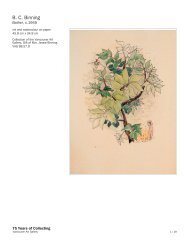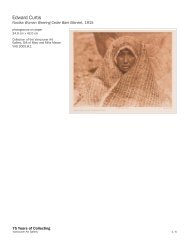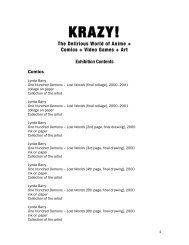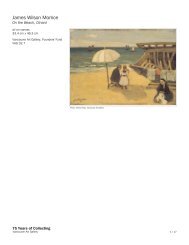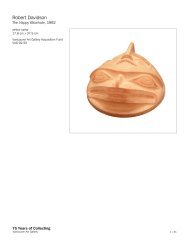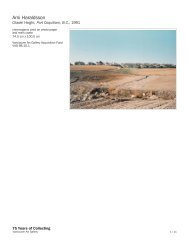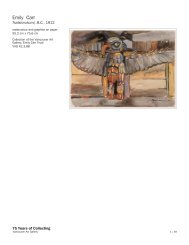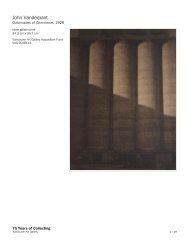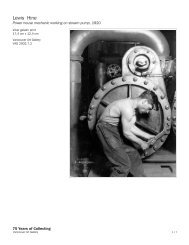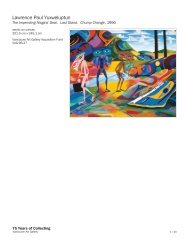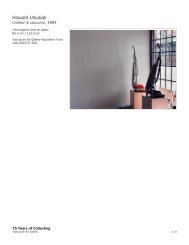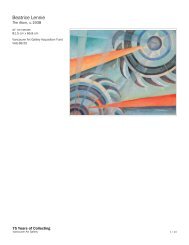A. Y. Jackson - 75 Years of Collecting - Vancouver Art Gallery
A. Y. Jackson - 75 Years of Collecting - Vancouver Art Gallery
A. Y. Jackson - 75 Years of Collecting - Vancouver Art Gallery
You also want an ePaper? Increase the reach of your titles
YUMPU automatically turns print PDFs into web optimized ePapers that Google loves.
A. Y. <strong>Jackson</strong><br />
The Road to St. Fidele, 1929-1930<br />
oil on canvas<br />
62.0 cm x 80.0 cm<br />
<strong>Vancouver</strong> <strong>Art</strong> <strong>Gallery</strong>,<br />
Founders' Fund<br />
VAG 32.5<br />
<strong>75</strong> <strong>Years</strong> <strong>of</strong> <strong>Collecting</strong><br />
<strong>Vancouver</strong> <strong>Art</strong> <strong>Gallery</strong><br />
Courtesy <strong>of</strong> the Estate <strong>of</strong> the late Dr. Naomi <strong>Jackson</strong> Groves<br />
Photo: Teresa Healy, <strong>Vancouver</strong> <strong>Art</strong> <strong>Gallery</strong><br />
1 / 18
A. Y. <strong>Jackson</strong><br />
The Road to St. Fidele, 1929-1930<br />
Image source: <strong>Vancouver</strong> <strong>Art</strong> <strong>Gallery</strong> Library:<br />
Canadian <strong>Art</strong>ist Files<br />
<strong>75</strong> <strong>Years</strong> <strong>of</strong> <strong>Collecting</strong><br />
<strong>Vancouver</strong> <strong>Art</strong> <strong>Gallery</strong><br />
<strong>Art</strong>ist's Biography<br />
Nationality: Canadian<br />
Born: 1882-10-03, Montreal, Quebec<br />
Died: 1974-04-05<br />
A.Y. <strong>Jackson</strong> was born in Montreal. Early in life his father left home and the<br />
family <strong>of</strong> seven had to manage more or less on its own. He was a good student,<br />
but had to leave school at the early age <strong>of</strong> 12 to earn money to help support his<br />
family. He became a lithographer and after six years <strong>of</strong> work was making $6.00<br />
a week. During this time he became interested in art.<br />
In 1905 and 1907 he saved up enough money for two trips. First he went to<br />
London for a brief visit. Next he went to Paris where he lived and studied until<br />
1908. He then returned to Canada and began to paint in the area <strong>of</strong><br />
Sweetsburg. His painting Edge <strong>of</strong> the Maple Wood brought him into contact<br />
with Lawren Harris. After another brief visit to France in 1911, he returned to<br />
Canada where he exhibited for the first time in Montreal. Shortly after the<br />
exhibition, <strong>Jackson</strong> received a letter from J.E.H. MacDonald asking on behalf <strong>of</strong><br />
Harris for Edge <strong>of</strong> Maple Wood and urging him to come to Toronto.<br />
In 1912 <strong>Jackson</strong> met John Varley, MacDonald, and <strong>Art</strong>hur Lismer at the <strong>Art</strong>s<br />
and Letters Club in Toronto. During a trip to Georgian Bay in September <strong>of</strong><br />
1912, <strong>Jackson</strong> met Dr. MacCallum who urged him to paint full-time in the<br />
Studio Building that Harris and he were financing. Dr. MacCallum also promised<br />
to assume <strong>Jackson</strong>'s expenses for a year, an <strong>of</strong>fer that he had also made to Tom<br />
Thomson. In 1913, <strong>Jackson</strong>'s canvas Terre Sauvage became the prototype for<br />
large works by the Group <strong>of</strong> Seven.<br />
<strong>Jackson</strong> went to war in 1914. Soon after being wounded in 1916, he became a<br />
war artist.<br />
<strong>Jackson</strong> went with Harris, MacDonald and Franz Johnston to Algoma in 1919<br />
and 1920. The group lived in a box-car shunted to various places by CNR and<br />
CPR. Like MacDonald, <strong>Jackson</strong> found the country inspiring.<br />
In 1920 <strong>Jackson</strong> and his friends formed the Group <strong>of</strong> Seven and held their first<br />
exhibition as such. He believed his own work, Terre Sauvage, to be the most<br />
radical in the show. The paintings were badly received by critics who deemed<br />
them "products <strong>of</strong> a deranged mind," "art gone mad" and "the cult <strong>of</strong> ugliness."<br />
From 1921-1924 <strong>Jackson</strong> painted in Quebec. In 1927, 1928 and 1930<br />
<strong>Jackson</strong> went to the Arctic. He went twice with Dr. Banting and once with<br />
Harris. In 1933 the Group <strong>of</strong> Seven dissolved. <strong>Jackson</strong> felt that the move to<br />
disband the group was a wise one. He continued to paint until his death in<br />
1974.<br />
Source: Unattributed notes in <strong>Vancouver</strong> <strong>Art</strong> <strong>Gallery</strong> Library Permanent Collection<br />
Files: <strong>Jackson</strong>, A.Y.<br />
2 / 18
A. Y. <strong>Jackson</strong><br />
The Road to St. Fidele, 1929-1930<br />
<strong>75</strong> <strong>Years</strong> <strong>of</strong> <strong>Collecting</strong><br />
<strong>Vancouver</strong> <strong>Art</strong> <strong>Gallery</strong><br />
<strong>Art</strong>istic Context<br />
Nationality: Canadian<br />
Training: Académie Julian, Paris<br />
Group: Group <strong>of</strong> Seven; Canadian Group <strong>of</strong> Painters; Canadian War Memorials;<br />
19th century; 20th century<br />
Contemporaries: Frank Carmichael, Lawren Harris, Frank Johnston, <strong>Art</strong>hur<br />
Lismer, J. E. H. MacDonald, Frederick Varley, Tom Thomsom<br />
Provenance: purchased from the artist in 1932<br />
Subject: landscape; land based nationalism; winter<br />
Other works in the <strong>Vancouver</strong> <strong>Art</strong> <strong>Gallery</strong> Collection<br />
A.Y. <strong>Jackson</strong><br />
Wild Woods, 1946<br />
oil on canvas<br />
T. Eaton Company Fund<br />
VAG 49.1<br />
Freddy Channel, Georgian Bay, 1920<br />
oil on panel<br />
Gift <strong>of</strong> Dr. & Mrs. Lawren S. Harris<br />
VAG 51.18<br />
A.Y. <strong>Jackson</strong><br />
Lake MacDonald, Algoma, 1920<br />
oil on wood panel<br />
Gift <strong>of</strong> Dr. & Mrs. Lawren S. Harris<br />
VAG 51.19<br />
A.Y <strong>Jackson</strong><br />
Making the Grade, Montreal, 1915<br />
oil on panel<br />
Gift <strong>of</strong> Dr. & Mrs. Lawren S. Harris<br />
VAG 51.20<br />
A.Y. <strong>Jackson</strong><br />
Beaver Country, Algoma, 1920<br />
oil on wood panel<br />
Gift <strong>of</strong> Dr. & Mrs. Lawren S. Harris<br />
VAG 51.21<br />
A.Y <strong>Jackson</strong>.<br />
Wartz Lake, Algoma, 1920<br />
oil on wood panel<br />
Gift <strong>of</strong> Dr. & Mrs. Lawren S. Harris<br />
VAG 51.22<br />
A.Y. <strong>Jackson</strong><br />
Early Spring, Georgian Bay, 1920<br />
oil on board<br />
Gift <strong>of</strong> Dr. & Mrs. Lawren S. Harris<br />
VAG 54.6<br />
3 / 18
A. Y. <strong>Jackson</strong><br />
The Road to St. Fidele, 1929-1930<br />
<strong>75</strong> <strong>Years</strong> <strong>of</strong> <strong>Collecting</strong><br />
<strong>Vancouver</strong> <strong>Art</strong> <strong>Gallery</strong><br />
A.Y. <strong>Jackson</strong><br />
Macintosh Bay, Lake Athabaska, Saskatchewan, 1957<br />
oil on canvas<br />
Gift <strong>of</strong> the <strong>Vancouver</strong> <strong>Art</strong> <strong>Gallery</strong> Women's Auxiliary<br />
VAG 68.21<br />
A.Y. <strong>Jackson</strong><br />
Ste. Louise, Quebec; Ste. Louis, Quebec (sic), 1940<br />
oil on wood panel<br />
Anonymous Gift<br />
VAG 82.4<br />
A.Y. <strong>Jackson</strong><br />
Untitled date unknown<br />
oil on panel<br />
Anonymous Gift<br />
VAG 82.6<br />
A.Y. <strong>Jackson</strong><br />
Laurentian Village, 1930<br />
oil on wood panel<br />
Gift <strong>of</strong> Garth Thurber<br />
VAG 86.60<br />
A.Y. <strong>Jackson</strong><br />
Skeena,1926<br />
pencil on wove paper<br />
Gift <strong>of</strong> Naomi <strong>Jackson</strong> Groves<br />
VAG 88.39.3<br />
A.Y. <strong>Jackson</strong><br />
Totem Poles and House at Kispiox, BC,1926<br />
pencil on wove paper<br />
Gift <strong>of</strong> Naomi <strong>Jackson</strong> Groves<br />
VAG 88.39.4<br />
A.Y. <strong>Jackson</strong><br />
Indian House, Port Simpson,1926<br />
pencil on wove paper<br />
Gift <strong>of</strong> Naomi <strong>Jackson</strong> Groves<br />
VAG 88.39.5<br />
A.Y. <strong>Jackson</strong><br />
Crossing Great Slave Lake by NightOw, 1928<br />
pencil, whiting on wove paper<br />
Gift <strong>of</strong> Naomi <strong>Jackson</strong> Groves<br />
VAG 88.39.6<br />
A.Y. <strong>Jackson</strong><br />
Williams Lake, 1949<br />
pencil on wove paper<br />
Gift <strong>of</strong> Naomi <strong>Jackson</strong> Groves<br />
VAG 88.39.11<br />
A.Y. <strong>Jackson</strong><br />
Hemlock, Prince Rupert, 1926<br />
pencil on wove paper<br />
Gift <strong>of</strong> Naomi <strong>Jackson</strong> Groves<br />
VAG 88.39.12<br />
4 / 18
A. Y. <strong>Jackson</strong><br />
The Road to St. Fidele, 1929-1930<br />
<strong>75</strong> <strong>Years</strong> <strong>of</strong> <strong>Collecting</strong><br />
<strong>Vancouver</strong> <strong>Art</strong> <strong>Gallery</strong><br />
A.Y. <strong>Jackson</strong><br />
Grand River, Early Spring, 1952<br />
oil on canvas<br />
Gift <strong>of</strong> Jack Smith<br />
VAG 88.41.1<br />
A.Y. <strong>Jackson</strong><br />
Barkerville, B. C.,1949<br />
oil on panel<br />
Gift <strong>of</strong> Jack Smith<br />
VAG 89.41.2<br />
A.Y. <strong>Jackson</strong><br />
Mission Road, 1949<br />
oil on wood panel<br />
Bequest <strong>of</strong> Ms. Evelyn Cornwall<br />
VAG 93.33<br />
A.Y. <strong>Jackson</strong><br />
St. Tites des Caps, 1923<br />
graphite on paper<br />
Gift <strong>of</strong> Dr. Naomi <strong>Jackson</strong> Groves<br />
VAG 98.44.1<br />
A.Y. <strong>Jackson</strong><br />
Des Renards, 1930<br />
graphite on paper<br />
Gift <strong>of</strong> Dr. Naomi <strong>Jackson</strong> Groves<br />
VAG 98.44.2<br />
A.Y. <strong>Jackson</strong><br />
The Red Cedar, c. 1936<br />
graphite on paper<br />
Gift <strong>of</strong> Dr. Naomi <strong>Jackson</strong> Groves<br />
VAG 98.44.3<br />
A.Y. <strong>Jackson</strong><br />
The Red Cedar, c.1936<br />
graphite on paper<br />
Gift <strong>of</strong> Dr. Naomi <strong>Jackson</strong> Groves<br />
VAG 98.44.4<br />
A.Y. <strong>Jackson</strong><br />
Landscape(recto); Dead Tree (verso), c.1938<br />
graphite on paper<br />
Gift <strong>of</strong> Dr. Naomi <strong>Jackson</strong> Groves<br />
VAG 98.44.5a-b<br />
A.Y. <strong>Jackson</strong><br />
Alaska Highway (recto), 1943<br />
graphite on paper<br />
Gift <strong>of</strong> Dr. Naomi <strong>Jackson</strong> Groves<br />
VAG 98.45 a-b<br />
A.Y. <strong>Jackson</strong><br />
Landscape, c.1920<br />
oil on panel<br />
The Parnell Bequest<br />
VAG 2000.39.3<br />
5 / 18
A. Y. <strong>Jackson</strong><br />
The Road to St. Fidele, 1929-1930<br />
<strong>75</strong> <strong>Years</strong> <strong>of</strong> <strong>Collecting</strong><br />
<strong>Vancouver</strong> <strong>Art</strong> <strong>Gallery</strong><br />
A.Y. <strong>Jackson</strong><br />
Beaver Swamp Near Perth, Ontario c. 1940<br />
oil on panel<br />
Gift <strong>of</strong> Robert George Curtis in memory <strong>of</strong> his mother Doris G. Curtis<br />
VAG 2001.34.1<br />
Bibliography<br />
As We See It: An Exhibition <strong>of</strong> Canadian <strong>Art</strong><br />
Publication<br />
[transcription]<br />
ANDREW YOUNG JACKSON<br />
A.Y. <strong>Jackson</strong> was born in Montreal in 1882. He was gifted with a down to earth<br />
sense <strong>of</strong> humour that was reflected in his art and provided friends and fellow<br />
artists with many hours <strong>of</strong> enjoyment. Often<br />
it lead him to make wry statements on the state <strong>of</strong> the Canadian art world. In<br />
1925, recalling those years <strong>of</strong> discouragement with the public's lack <strong>of</strong><br />
enthusiasm for a style <strong>of</strong> art that he felt reflected the feeling <strong>of</strong> his country<br />
<strong>Jackson</strong> wrote, "It was boasted in Montreal that more Dutch art was sold there<br />
than in any other city on this continent. Dutch pictures became a symbol <strong>of</strong><br />
social position and wealth...they collected them like cigarette cards. You had to<br />
complete your set...the housed bulged with cows, old women peeling potatoes<br />
and windmills...they were grey, mild in<strong>of</strong>fensive things, and when surrounded by<br />
heavy gold frames, covered with plate glass and a spotlight over them, they<br />
looked expensive."<br />
Like so many artists <strong>of</strong> his time, <strong>Jackson</strong> had studied in Europe and had<br />
acquired a knowledge <strong>of</strong> historical and modern art. But he was determined to<br />
apply this knowledge to expressing Canadian moods and scenes.<br />
<strong>Jackson</strong> was eventually credited with developing new techniques that did indeed<br />
successfully present the atmosphere <strong>of</strong> winter days with the<br />
colours <strong>of</strong> shadow reflecting on the snow.<br />
One <strong>of</strong> <strong>Jackson</strong>'s landmark compositions was created in 1910 while living in<br />
Emileville Quebec—EDGE OF THE MAPLE WOOD. At this time J.E.H. MacDonald<br />
wrote to <strong>Jackson</strong> concerning the painting and it was then <strong>Jackson</strong> stated, "I<br />
began my association with the artists responsible for changing the course <strong>of</strong><br />
Canadian art for many years to come."<br />
<strong>Jackson</strong>, through MacDonald, eventually met other members <strong>of</strong> the yet to be<br />
Group <strong>of</strong> Seven and developed lasting friendships. During this time Tom<br />
Thompson and <strong>Jackson</strong> worked closely together and had an equal influence on<br />
each others work.<br />
A.Y. <strong>Jackson</strong> produced a great amount <strong>of</strong> work during his lifetime but his favorite<br />
canvas was FIRST SNOW, ALMA, a panel painted while on a 1919 box-car trip,<br />
his first glimpse <strong>of</strong> Alma.<br />
His strongest work was created during the 1920s and 1930s, and his later work<br />
is noted for its depiction <strong>of</strong> light and use <strong>of</strong> strong curved strokes in his<br />
landscapes.<br />
6 / 18
A. Y. <strong>Jackson</strong><br />
The Road to St. Fidele, 1929-1930<br />
<strong>75</strong> <strong>Years</strong> <strong>of</strong> <strong>Collecting</strong><br />
<strong>Vancouver</strong> <strong>Art</strong> <strong>Gallery</strong><br />
A.Y. <strong>Jackson</strong><br />
Publication<br />
[transcription]<br />
VANCOUVER ART GALLERY COLLECTION<br />
A.Y. <strong>Jackson</strong><br />
The Road to St. Fidele, 1929-1930<br />
oil on canvas<br />
63.8 x 81.6 cm<br />
<strong>Vancouver</strong> <strong>Art</strong> <strong>Gallery</strong>, Founders Fund<br />
VGA 32.5<br />
We had come together because we felt that art in Canada was mild and<br />
ineffective and obsessed with traditions which in Europe had long been<br />
discarded.<br />
The Group <strong>of</strong> Seven—A.Y. <strong>Jackson</strong>, Lawren Harris, Franklin Carmichael, Fred<br />
Varley, Frank Johnston, J.E.H. MacDonald and <strong>Art</strong>hur Lismer—have pr<strong>of</strong>oundly<br />
shaped the history <strong>of</strong> art in this country. When they began exhibiting together in<br />
1920, their mission was to express what they saw as the reality <strong>of</strong> the Canadian<br />
landscape. Their perceptions were based on aspects <strong>of</strong> the northern Ontario<br />
countryside still largely untouched by humankind, places that seemed to define<br />
a nationalistic notion <strong>of</strong> "wilderness."<br />
For A.Y. <strong>Jackson</strong>, the discovery <strong>of</strong> the Canadian landscape was a somewhat<br />
circuitous journey. Born in Montreal in 1882, to a working class family,<br />
<strong>Jackson</strong>'s first exposure to art was through employment in a commercial<br />
lithography plant. There, he made his way from sweeping floors to designing<br />
labels for a variety <strong>of</strong> products. His interest in design and drawing sparked, he<br />
began to paint in the countryside and eventually decided that he needed to<br />
study abroad. <strong>Jackson</strong> worked his way to Paris in 1907, enrolled in the<br />
Academe DE la Grand-Chummier, traveled through France and Italy, and was<br />
exposed to the style <strong>of</strong> the Post-Impressionists. He was particularly influenced<br />
by their use <strong>of</strong> bright colour, and by the experience <strong>of</strong> plain-air or outdoor<br />
painting. Returning to Canada in 1909, he resumed commercial art work, but<br />
more importantly began to paint the landscape in the townships east <strong>of</strong><br />
Montreal.<br />
The exhibition <strong>of</strong> one these paintings in Toronto simulated the interest <strong>of</strong> Lawren<br />
Harris and his colleagues, who invited <strong>Jackson</strong> to come to that city to work with<br />
them. He arrived in Toronto in 1913, and met most <strong>of</strong> the men who were to<br />
become his fellows in the Group <strong>of</strong> Seven. He also worked closely with Tom<br />
Thomson, sketching with him in Algonquin Park, sharing a studio with him in<br />
Toronto, and exhibiting with him.<br />
Following the war, during which he served as both soldier and Official War <strong>Art</strong>ist,<br />
<strong>Jackson</strong> returned to Toronto. With Harris, he took a number <strong>of</strong> sketching trips to<br />
the Alma region <strong>of</strong> Ontario, camping out in an old box car. These trips enabled<br />
<strong>Jackson</strong> to come to terms with his war experience and to reaffirm his<br />
commitment to the Canadian landscape as subject matter.<br />
The <strong>Vancouver</strong> <strong>Art</strong> <strong>Gallery</strong> has a number <strong>of</strong> sketches which give a clear idea <strong>of</strong><br />
<strong>Jackson</strong>’s working methods and his choice <strong>of</strong> subject matter. Early Spring,<br />
Georgian Bay and The Freddy Channel, Georgian Bay,both done in March<br />
1920, depict aspects <strong>of</strong> nature which are, at first glance, inhospitable. Warts<br />
7 / 18
A. Y. <strong>Jackson</strong><br />
The Road to St. Fidele, 1929-1930<br />
<strong>75</strong> <strong>Years</strong> <strong>of</strong> <strong>Collecting</strong><br />
<strong>Vancouver</strong> <strong>Art</strong> <strong>Gallery</strong><br />
Lake, Alma, probably also from early in 1920, is a desolate landscape with burnt<br />
trees and a brown, uninhabited landscape. There is little alluring about these<br />
prospects ”no anecdotal detail, no human presence“ but the forms have a<br />
compelling strength and conviction. By choosing non-human subjects, <strong>Jackson</strong><br />
emphatically stated his case for the value <strong>of</strong> the landscape. And by choosing<br />
images <strong>of</strong> destruction and decay, he worked through his devastating experience<br />
<strong>of</strong> war.<br />
A more positive mood is seen in the extensive series <strong>of</strong> Quebec landscapes<br />
<strong>Jackson</strong> produced throughout his career. Starting in the early 1920s, <strong>Jackson</strong><br />
regularly visited what he called "Christmas card country." He sketched there in<br />
the late winter and early spring, just as the snow was beginning to melt and the<br />
temperature allowed him to work outdoors. <strong>Jackson</strong>'s use <strong>of</strong> colour, such as his<br />
pink and blue snow, is strongly reminiscent <strong>of</strong> the French modernists. But more<br />
than a little nostalgia prevails in his images <strong>of</strong> small settlements and rolling hills:<br />
none <strong>of</strong> the power poles carries wires, and automobiles are rarely seen.<br />
Of all the members <strong>of</strong> the Group <strong>of</strong> Seven, <strong>Jackson</strong> was the most widely<br />
traveled. The 1920s saw him painting in British Columbia and the Arctic, as well<br />
as Ontario and Quebec, and the following decades saw him visiting Alberta, the<br />
Yukon and Northwest Territories and, again, his beloved Quebec. There are no<br />
radical changes in <strong>Jackson</strong>'s later work, but rather a refining <strong>of</strong> detail and a<br />
continued interest in depicting distant regions <strong>of</strong> Canada.<br />
<strong>Jackson</strong> was a tireless promoter <strong>of</strong> Canadian art and the Canadian landscape<br />
and, by the time <strong>of</strong> his death in 1974, he had completed his mission. He had,<br />
with his colleagues, transformed our perception <strong>of</strong> Canada.<br />
Ian M. Thom<br />
Suggestions for Further Reading<br />
<strong>Jackson</strong>, A.Y. A Painter’s Country. Toronto: Clarke, Irwin and Company Ltd.,<br />
1958 (and subsequent editions).<br />
Groves, Naomi <strong>Jackson</strong>. A.Y.’s Canada. Toronto: Clarke, Irwin and<br />
Company Ltd., 1968<br />
Reid, Dennis. Alberta Rhythm: The Later Work <strong>of</strong> A.Y. <strong>Jackson</strong>. Toronto: <strong>Art</strong><br />
<strong>Gallery</strong> <strong>of</strong> Ontario, 1982<br />
8 / 18
A. Y. <strong>Jackson</strong><br />
The Road to St. Fidele, 1929-1930<br />
<strong>75</strong> <strong>Years</strong> <strong>of</strong> <strong>Collecting</strong><br />
<strong>Vancouver</strong> <strong>Art</strong> <strong>Gallery</strong><br />
<strong>Vancouver</strong> <strong>Art</strong> <strong>Gallery</strong>: All-Canadian Exhibition<br />
Publication<br />
1932<br />
[transcription <strong>of</strong> excerpt]<br />
VANCOUVER ART GALLERY<br />
ALL CANADIAN EXHIBITION<br />
MAY TO JULY, 1932<br />
Price 15 Cents<br />
<strong>Vancouver</strong> <strong>Art</strong> <strong>Gallery</strong><br />
All-Canadian Exhibition<br />
May to July 1932<br />
Judging Committee<br />
Willie Dalton (Chairman)<br />
H.A. Stone<br />
H. Mortimer Lamb<br />
J.W.G MacDonald<br />
G.L. Thornton Sharp<br />
J. Vanderpant<br />
W.P. Weston<br />
FOREWARD<br />
In arranging the All-Canadian Exhibition, the aim <strong>of</strong> the Exhibition committee has<br />
been to gather from all parts <strong>of</strong> Canada a collection <strong>of</strong> pictures and sculpture<br />
that shall be representative <strong>of</strong> all that is best in Canadian <strong>Art</strong>, both past and<br />
present. <strong>Art</strong>ists resident in British Columbia have contributed their quota and<br />
the Judging committee has endeavored to ensure that the work submitted shall<br />
have every opportunity for display side by side with works <strong>of</strong> art drawn from all<br />
parts <strong>of</strong> the Dominion. The Committee desires to express its sincere thanks to<br />
the Directors <strong>of</strong> the National <strong>Gallery</strong> <strong>of</strong> Canada, to Mr. E. Wyley Grier, President<br />
<strong>of</strong> the Royal Canadian Academy and to the other friends <strong>of</strong> the <strong>Gallery</strong> for their<br />
work in selecting pictures from Eastern Canada, and for the co-operation and<br />
advice so generously afforded.<br />
Before the Exhibition closes, it is anticipated that the Founders will select certain<br />
pictures as a nucleus <strong>of</strong> a Permanent Collection <strong>of</strong> Canadian <strong>Art</strong>.<br />
Willie Dalton<br />
Chairman<br />
61. The Road to St. Fidele A.Y. <strong>Jackson</strong> R.C.A.<br />
[11 in red ink]<br />
9 / 18
A. Y. <strong>Jackson</strong><br />
The Road to St. Fidele, 1929-1930<br />
<strong>75</strong> <strong>Years</strong> <strong>of</strong> <strong>Collecting</strong><br />
<strong>Vancouver</strong> <strong>Art</strong> <strong>Gallery</strong><br />
Souvenir Catalogue: Opening the New <strong>Vancouver</strong> <strong>Art</strong> <strong>Gallery</strong>, 1951.<br />
Publication<br />
1951-09-26<br />
[transcription]<br />
SOUTH GALLERY<br />
CANADIAN PICTURES FROM OUR PERMANENT COLLECTION<br />
Soon after its foundation, the <strong>Vancouver</strong> <strong>Art</strong> <strong>Gallery</strong> was presented by the<br />
Founders with three Canadian paintings, by James W. Morrice, A. Y. <strong>Jackson</strong>,<br />
and H. Mabel May respectively. These three pictures are hanging in this<br />
exhibition and, as one may see, constituted an auspicious beginning for the<br />
building <strong>of</strong> a Canadian collection.<br />
The Morrice, "On the Beach, Dinard", is a small but fine example <strong>of</strong> this most<br />
sensitive and lyrical <strong>of</strong> Canadian painters who died in 1924. The A. Y. <strong>Jackson</strong>,<br />
"Road to St. Fidele" is typical <strong>of</strong> the full rhythmic style which distinguishes his<br />
position in the Group <strong>of</strong> Seven, the first concerted movement in Canadian<br />
painting history. A dramatic <strong>Art</strong>hur Lismer, "Pine Trees, Georgian Bay", a soberly<br />
splendid J. E. H. MacDonald, "Church by the Sea", a discerning and painterly<br />
portrait <strong>of</strong> H. Mortimer Lamb by F. H. Varley (all three the gift <strong>of</strong> Mr. Lamb), and<br />
a brilliant later <strong>Jackson</strong>, further represent work by the original 'Seven'. Lawren<br />
Harris, also a member <strong>of</strong> the Group, is represented in this selection by a very<br />
recent work.<br />
The influence <strong>of</strong> the Group was evidenced in the broad landscape style which<br />
dominated Canadian painting for some years, a good example <strong>of</strong> which is here<br />
shown in Mabel May's "Autumn in the Laurentians". (This spring the <strong>Gallery</strong> will<br />
hold an exhibition <strong>of</strong> the work <strong>of</strong> Miss May who now lives in <strong>Vancouver</strong>). The<br />
tradition <strong>of</strong> landscape, <strong>of</strong> course, has continued right up to the present in<br />
varying personal interpretations: David Milne, best known for his delicate<br />
imaginative watercolors, here shows a brilliantly executed oil; Edward Hughes, a<br />
Victoria painter, hangs a landscape <strong>of</strong> arresting intentness; James MacDonald, a<br />
young <strong>Vancouver</strong> painter, brings the landscape to the city in a richly painted<br />
canvas.<br />
Since the time <strong>of</strong> the Group <strong>of</strong> Seven, new elements, new trends, already<br />
manifest elsewhere, have been finding their expression in our painting. Some <strong>of</strong><br />
them are reflected in this exhibition. There is the showy realism <strong>of</strong> W. A. Winter's<br />
"Midnight at Charlie's"; the melancholy <strong>of</strong> Jack Nichols' turpentine wash painting<br />
<strong>of</strong> children, the loneliness <strong>of</strong> Don Jarvis' "Old Man"; the element <strong>of</strong> expressionism<br />
present in Fritz Brandtner's semi-abstract landscape. There is too, the concern<br />
with form, to a greater or lesser degree stripped <strong>of</strong> its representational<br />
references: as in Molly Bobak, for its sensuous life; as in B.C. Binning for its own<br />
structural life; as in the Lawren Harris as a means to a metaphysical meaning.<br />
This selection <strong>of</strong> painting well demonstrates that this <strong>Gallery</strong> may be proud <strong>of</strong> its<br />
Canadian collection, and Canada <strong>of</strong> her painters.<br />
DORIS SHADBOLT<br />
<strong>Vancouver</strong> <strong>Art</strong> <strong>Gallery</strong> Docent<br />
10 / 18
A. Y. <strong>Jackson</strong><br />
The Road to St. Fidele, 1929-1930<br />
<strong>75</strong> <strong>Years</strong> <strong>of</strong> <strong>Collecting</strong><br />
<strong>Vancouver</strong> <strong>Art</strong> <strong>Gallery</strong><br />
Canadian Pictures, 1951<br />
Publication<br />
1982<br />
[transcription]<br />
The <strong>Vancouver</strong> <strong>Art</strong> <strong>Gallery</strong><br />
CANADIAN PICTURES, 1951<br />
December 4, 1982 - March 20, 1983<br />
This exhibition was first hung in September, 1951, for the opening <strong>of</strong> the<br />
expanded and renovated <strong>Vancouver</strong> <strong>Art</strong> <strong>Gallery</strong>. The exhibition was meant to<br />
show the gallery's Canadian holdings. Needless to say, 31 years later, our<br />
Canadian collection is much richer than this small but strong beginning. In<br />
rehanging this exhibition as we prepare to leave this building—cramped and out<br />
<strong>of</strong> date now, but Canada's most modern gallery then—we have an opportunity to<br />
see what Canadian painting meant over thirty years ago.<br />
The works demonstrate currents in Canadian art history which were prevalent at<br />
the time. The Group <strong>of</strong> Seven are represented with their spiritual topographies <strong>of</strong><br />
Canada's North. Social Realism, a movement in Canadian painting <strong>of</strong> the 30's<br />
and 40's which reacted to the lack <strong>of</strong> a human element in the Group <strong>of</strong> Seven's<br />
work, is represented by Bill Winter and Orville Fisher; the existential city by Don<br />
Jarvis, Jim MacDonald and Ghitta Caiserman, and the move to abstraction in the<br />
work <strong>of</strong> Lawren Harris, Fritz Brandtner and B.C. Binning.<br />
Painted before the influx <strong>of</strong> American ideas about painting, these works are all<br />
fairly small in scale. They are easel paintings, meant for private homes in an era,<br />
before <strong>Art</strong> Bank, The Canada Council and the growth <strong>of</strong> corporate collecting,<br />
when the sale <strong>of</strong> pictures to a private patron was still the major source <strong>of</strong><br />
income (other than teaching) for artists in Canada.<br />
These works also deal with images and subject-matter and have a great deal <strong>of</strong><br />
interest as documents. That is, they record personal views <strong>of</strong> the world the<br />
artists lived in and are kind <strong>of</strong> a window to the past. Although the styles<br />
exhibited here might seem rigid or stiff today, we should remember that many <strong>of</strong><br />
these artists were emerging from training that was grounded in nineteenth<br />
century techniques that emphasized drawing over "painting". And works like<br />
these, where line and colour are used for their emotional impact, are very much<br />
in a tradition which, far from being dead, we see revived in the "new" painting <strong>of</strong><br />
the 1980's.<br />
Scott Watson<br />
Curator<br />
[Pine, Georgian Bay in blue ink]<br />
11 / 18
A. Y. <strong>Jackson</strong><br />
The Road to St. Fidele, 1929-1930<br />
<strong>75</strong> <strong>Years</strong> <strong>of</strong> <strong>Collecting</strong><br />
<strong>Vancouver</strong> <strong>Art</strong> <strong>Gallery</strong><br />
Canadian Traditions<br />
Publication<br />
1985<br />
[transcription]<br />
CANADIAN TRADITIONS<br />
From the <strong>Vancouver</strong> <strong>Art</strong> <strong>Gallery</strong> Collection<br />
The <strong>Vancouver</strong> <strong>Art</strong> <strong>Gallery</strong> has extensive holdings <strong>of</strong> Canadian art in its<br />
collection. This exhibition features a selection <strong>of</strong> those holdings to represent<br />
certain aspects <strong>of</strong> the Canadian tradition.<br />
The earliest works are portraits and landscapes by eastern Canadian painters<br />
who worked in European traditions. Paul Peel was a student <strong>of</strong> the academic<br />
Parisian artist, Jean-Leon Gérome. His highly polished surface and interest in<br />
domestic allegory are seen in his Reading the Future, 1883. Twentieth century<br />
figurative and portrait works include Frederick Varley's (1881-1969) Untitled<br />
Figure Study, 1939 and Randolph Stanley Hewton's (1888-1960) art deco<br />
portrait <strong>of</strong> Mrs Thomas Caverhill nee Robertson, 1925. Early landscapes include<br />
Cornelius Kriegh<strong>of</strong>f's (1815-1872) Indian Encampment which is typical <strong>of</strong> the<br />
nineteenth century European idealization <strong>of</strong> Indian life. Kriegh<strong>of</strong>f immigrated to<br />
Canada as a relatively young man in his early thirties and lived here most <strong>of</strong> his<br />
life. The influence <strong>of</strong> French Impressionism is seen in Quebec artist Marc Auréle<br />
de Foy Suzor-Coté's (1869-1937) Winter Street Scene, 1918, while Homer<br />
Watson's (1855-1936) The Load <strong>of</strong> Grass, c. 1898, harks back to the romantic<br />
tradition with its noble treatment <strong>of</strong> the pastoral landscape. Earthy colours and<br />
thick paint are used to express a rapport with rural nature.<br />
But the strength <strong>of</strong> this gallery's Canadian collection is in the modern period.<br />
Tom Thomson's (1887-1917) Nocturne, 1915, is a brilliant oil sketch which<br />
creates a sensation <strong>of</strong> pure colour—an abstract sensation meant to correspond<br />
with a feeling for landscape. Thomson's achievement, which was cut short by his<br />
premature death in 1917 at the age <strong>of</strong> thirty, was a major inspiration for Lawren<br />
Harris (1885-1970) and the Group <strong>of</strong> Seven.<br />
Harris believed that the imagery <strong>of</strong> the north was a national spiritual heritage<br />
and he endeavoured, in the 1920s, to render the bleak but sublime northern<br />
terrain in terms <strong>of</strong> a metaphysical geometry. By 1940, he had moved on from<br />
representational art to paint visionary abstract works which allied him to the<br />
Transcendentalists <strong>of</strong> the United States. He was an influence on, and an early<br />
supporter <strong>of</strong>, Emily Carr and spent the last 33 years <strong>of</strong> his life in <strong>Vancouver</strong><br />
where he made an enormous contribution to the introduction <strong>of</strong> modernist ideas<br />
in this city. Eleven very fine Harris drawings, recently donated to the gallery by<br />
his daughter, Mrs James H. Knox, will be exhibited for the first time.<br />
Works by other members <strong>of</strong> the Group, including two recently acquired paintings<br />
by A.Y. <strong>Jackson</strong> (1882-1974) are also included in the exhibition.<br />
The gallery also owns a fine selection <strong>of</strong> the work <strong>of</strong> David Milne (1882-1953).<br />
Milne pursued nature in a very Canadian way. Like Tom Thomson before him or<br />
the painters <strong>of</strong> the Group <strong>of</strong> Seven, he spent months in isolated wilderness in<br />
search <strong>of</strong> his motif. Milne disliked the idealism <strong>of</strong> the Group and forged a unique<br />
and individual vision <strong>of</strong> nature. His delicate and sensual watercolours are among<br />
the highlights <strong>of</strong> Canadian art history.<br />
Works <strong>of</strong> social commentary are also displayed. They include Maxwell Bates'<br />
(1906-1980) caustic canvas Beautiful B.C., 1966. Almost twenty years old this<br />
work still has the power to <strong>of</strong>fend and amuse.<br />
12 / 18
A. Y. <strong>Jackson</strong><br />
The Road to St. Fidele, 1929-1930<br />
<strong>75</strong> <strong>Years</strong> <strong>of</strong> <strong>Collecting</strong><br />
<strong>Vancouver</strong> <strong>Art</strong> <strong>Gallery</strong><br />
The experience <strong>of</strong> the Second World War is reflected in watercolours by Jack<br />
Shadbolt, a painting by Mary Ritter Hamilton and prints by Frederick Taylor. Also<br />
included are post-war works which demonstrate the strength <strong>of</strong> an expressionist<br />
tradition based on nature in Canadian painting. Works by Alistair Bell (b. 1913)<br />
and Jack Shabolt (b. 1909) depict nature not as ideal form but as growing and<br />
decaying substance and as a metaphor <strong>of</strong> the human condition in the modern<br />
world.<br />
Scott Watson<br />
<strong>Vancouver</strong> Collects<br />
Publication<br />
2001<br />
[transcription]<br />
THE GROUP OF SEVEN: CANADA'S NATIONAL SCHOOL OF PAINTERS<br />
New material demands new methods and new methods fling a challenge to<br />
old conventions. It is as impossible to depict the autumn pageantry <strong>of</strong> our<br />
northern woods with a lead pencil as it is to bind our young art with the<br />
conventions and methods <strong>of</strong> other climates and other ages.<br />
(Foreword to the catalogue <strong>of</strong> the 1922 Group <strong>of</strong> Seven exhibition, written by<br />
the artists)<br />
Established in 1920, the Group <strong>of</strong> Seven emerged from Toronto as a collective<br />
<strong>of</strong> self-proclaimed modern artists. The Group was initially drawn together by a<br />
common frustration with the conservative nature <strong>of</strong> most Canadian art <strong>of</strong> the<br />
time. The work in contention held up antiquated colonial traditions and a<br />
constraining imitative style that the Group chose to reject for new visual<br />
material, subject and methods. That new material and subject matter was found<br />
primarily in the Canadian wilderness: the Group sought to depict a raw Canada<br />
with a modern method and style that reflected the country's adolescent potential<br />
in the face <strong>of</strong> past tradition.<br />
The work <strong>of</strong> the Group <strong>of</strong> Seven has become for many Canadians synonymous<br />
with Canadian art, even for those who cannot identify all <strong>of</strong> the members <strong>of</strong> the<br />
Group. Although the Group <strong>of</strong> Seven was initially a movement concentrated in<br />
central Canada, their influence and importance was felt across the country.<br />
Indeed, <strong>of</strong> the ten members <strong>of</strong> the Group, seven visited or lived in British<br />
Columbia at one time or another to make their art.<br />
The first Group <strong>of</strong> Seven exhibition seen in BC was in 1922 and their work was<br />
also included in exhibitions in 1924, long before an art gallery was a permanent<br />
presence in the community. However, it was not until Varley arrived in <strong>Vancouver</strong><br />
in 1926 that the influence <strong>of</strong> the Group was directly felt in the work <strong>of</strong> this<br />
region. Varley's approach to landscape painting, going out into the landscape to<br />
paint directly from his subject matter, encouraged others to follow his example.<br />
13 / 18
A. Y. <strong>Jackson</strong><br />
The Road to St. Fidele, 1929-1930<br />
<strong>75</strong> <strong>Years</strong> <strong>of</strong> <strong>Collecting</strong><br />
<strong>Vancouver</strong> <strong>Art</strong> <strong>Gallery</strong><br />
The other member <strong>of</strong> the Group <strong>of</strong> Seven who had a major influence on the art<br />
and artists <strong>of</strong> this region was Lawren Harris. His influence can be seen first<br />
through his friendship with and support <strong>of</strong> Emily Carr, by which he directly<br />
altered the course <strong>of</strong> landscape painting. Secondly, when he lived in <strong>Vancouver</strong><br />
and his own work had become abstract, he encouraged artists to approach<br />
abstraction.<br />
The artists in the Group were held together by their stylistic and nationalistic<br />
ideology, presenting themselves as Canada's national school <strong>of</strong> painters. As a<br />
collective, they sought to affirm a contemporary nationalism through their<br />
depiction <strong>of</strong> a vast and rugged country. Stylistically, the artists in the Group were<br />
indebted to Post-Impressionism and Symbolism, recognizing their antecedents<br />
while they sought to modify their notions <strong>of</strong> "significant form" and colour analysis<br />
toward a bold method <strong>of</strong> pictorial expression. These formal modernist elements<br />
included a thick paint surface, pure and brilliant colour and an incorporation <strong>of</strong><br />
design into a raw treatment <strong>of</strong> an unidealized landscape—especially when<br />
compared to nineteenth-century English and French landscape painting that<br />
carried over into the early cultural identity <strong>of</strong> Canada.<br />
Compared to modernist painting elsewhere at the time, the Group's work can<br />
appear conservative. However, within a Canadian context the artists forged a<br />
new visual language that attempted to break free <strong>of</strong> traditional cultural ties. The<br />
Group's manner <strong>of</strong> painting was seen by many <strong>of</strong> their contemporaries as crude<br />
or rough, mimicking the raw form and palette <strong>of</strong> the wilderness. Using the<br />
untamed Canadian landscape as fuel for their artistic and nationalistic goals, the<br />
Group put forth a new perception <strong>of</strong> beauty, one that spoke <strong>of</strong> a new world, its<br />
possibility and its freedom.<br />
The seven founding members <strong>of</strong> the Group included Franklin Carmichael, Lawren<br />
Harris, A.Y. <strong>Jackson</strong>, Franz Johnston, <strong>Art</strong>hur Lismer, J.E.H. MacDonald and F.H.<br />
Varley. This initial artistic coalition was formed in Toronto between 1911 and<br />
1913. All, including the independently wealthy Harris, worked as commercial<br />
artists at some point in their careers. Tom Thomson, another commercial artist,<br />
was included in the pre-Group circle, but his premature death in 1917<br />
precluded his <strong>of</strong>ficial membership in the Group. An avid outdoorsman, Thomson<br />
was significant to the Group in that he sparked an interest in painting the<br />
northern Ontario landscape, particularly in and around Algonquin Park.<br />
The rough wilderness <strong>of</strong> the landscape, its raw, dramatic austerity, coupled with<br />
breathtaking colour and light, spoke far more directly <strong>of</strong> Canada for these artists<br />
than anything to be found in the cities or settled areas. For them, the north, a<br />
constant motif in earlier discussions <strong>of</strong> Canadian identity, found its first<br />
expression in the rocks, burnt land, trees, colour and light <strong>of</strong> Algonquin Park.<br />
The fresh, "uncivilized" landscape <strong>of</strong> northern Canada became, for the Group and<br />
their proponents, synonymous with the promise <strong>of</strong> a young country.<br />
In order to increase awareness <strong>of</strong> the importance <strong>of</strong> art for the development <strong>of</strong><br />
Canada as a nation, the Group circulated their paintings across Canada during<br />
the 1920s (showing especially in western Canada, such as at the <strong>Vancouver</strong><br />
Exhibition in 1927 followed by exhibitions at the New Westminster Provincial<br />
Exhibition, in Edmonton and Calgary). The populist intent <strong>of</strong> their project is<br />
reflected in the words <strong>of</strong> Eric Brown, the director <strong>of</strong> the National <strong>Gallery</strong> <strong>of</strong><br />
Canada at the time, who said, "a great country needs a great art." During this<br />
time the Group also wrote numerous nationalistic articles about art and their<br />
country, illustrated Canadian books, decorated public buildings, wrote poetry and<br />
designed stage sets.<br />
In the mid-1920s the Group underwent a change in members. In 1926<br />
Johnston left the Group and A.J. Casson filled his spot until the Group disbanded<br />
14 / 18
A. Y. <strong>Jackson</strong><br />
The Road to St. Fidele, 1929-1930<br />
<strong>75</strong> <strong>Years</strong> <strong>of</strong> <strong>Collecting</strong><br />
<strong>Vancouver</strong> <strong>Art</strong> <strong>Gallery</strong><br />
in 1933. Four years later, in 1930, the Group widened its scope by including<br />
Edwin Holgate from Montreal, and in 1932 L.L. FitzGerald from Winnipeg joined<br />
the Group to further the representation <strong>of</strong> other provinces.<br />
The mythology built up around the Canadian wilderness by the members <strong>of</strong> the<br />
Group ran parallel with developments in literature, poetry and politics that<br />
sought to identify Canada with the North and a nationalism based on the land.<br />
The identification with the land has been one reason, amongst others, for their<br />
continued popularity and success.<br />
The first Canadian work <strong>of</strong> art purchased by the <strong>Vancouver</strong> <strong>Art</strong> <strong>Gallery</strong> was a<br />
landscape by A.Y. <strong>Jackson</strong> in 1932, and later Harris gave several works by<br />
himself and other members to the <strong>Gallery</strong>. The Group <strong>of</strong> Seven has an<br />
important, if modest, presence in the <strong>Vancouver</strong> <strong>Art</strong> <strong>Gallery</strong>'s permanent<br />
collection and is significantly present in several private collections in the<br />
community. This selection <strong>of</strong> work supplements the holdings <strong>of</strong> the <strong>Gallery</strong> with<br />
a group <strong>of</strong> excellent canvases drawn from <strong>Vancouver</strong> collections and gives an<br />
opportunity for the public to see works that were predominantly collected in the<br />
east.<br />
Melanie O'Brian and Ian Thom<br />
Further Reading<br />
A. Y. <strong>Jackson</strong>: Paintings, 1902-1953. Toronto, A.G. Ont., 1953.<br />
Firestone, O. J. The Other A. Y. <strong>Jackson</strong>. Toronto: McClelland and Stewart,<br />
1979.<br />
Groves, Naomi <strong>Jackson</strong>. One Summer in Quebec: A.Y. <strong>Jackson</strong> in 1925: A<br />
Family View. Ontario: Penumbra Press, 1988.<br />
Groves, Naomi. <strong>Jackson</strong>. A. Y.'s Canada. Toronto and <strong>Vancouver</strong>, 1968.<br />
Groves, Naomi <strong>Jackson</strong>. Works by A.Y. <strong>Jackson</strong> from the 1930s. Ottawa:<br />
Carleton University Press, 1990.<br />
<strong>Jackson</strong>, A.Y. A Painter's Country: The Autobiography <strong>of</strong> A. Y. <strong>Jackson</strong>. Toronto<br />
and <strong>Vancouver</strong>: Clarke Irwin, 1958.<br />
Larsen, Wayne. A.Y. <strong>Jackson</strong>: A Love for the Land. Montreal: XYZ Publishers,<br />
2003.<br />
Lismer, A. A. Y. <strong>Jackson</strong>: Thirty <strong>Years</strong> <strong>of</strong> Painting. Montreal: Dominion <strong>Gallery</strong>.,<br />
1946.<br />
Reid, Dennis. Alberta Rhythm: The Later Work <strong>of</strong> A.Y. <strong>Jackson</strong>. Toronto: <strong>Art</strong><br />
<strong>Gallery</strong> <strong>of</strong> Ontario, 1982.<br />
15 / 18
A. Y. <strong>Jackson</strong><br />
The Road to St. Fidele, 1929-1930<br />
<strong>75</strong> <strong>Years</strong> <strong>of</strong> <strong>Collecting</strong><br />
<strong>Vancouver</strong> <strong>Art</strong> <strong>Gallery</strong><br />
Exhibition History<br />
Exhibitions at the <strong>Vancouver</strong> <strong>Art</strong> <strong>Gallery</strong><br />
All Canadian Exhibition. May - July 1932.<br />
Opening the New <strong>Vancouver</strong> <strong>Art</strong> <strong>Gallery</strong>, 1951. September 26 - October 14,<br />
1951.<br />
Canadian Pictures, 1951. December 4, 1982 - March 20, 1983.<br />
Canadian Traditions. June 29, 1985 - October 6, 1985.<br />
<strong>Vancouver</strong> Collects: The Group <strong>of</strong> Seven. October 20, 2001 - January 20,<br />
2002.<br />
<strong>75</strong> <strong>Years</strong> <strong>of</strong> <strong>Collecting</strong>: British Masters, Group <strong>of</strong> Seven and Pop Icons.<br />
February 4, 2006 - May 14, 2006.<br />
Selected Exhibitions outside <strong>of</strong> the <strong>Vancouver</strong> <strong>Art</strong> <strong>Gallery</strong><br />
Victoria <strong>Art</strong> <strong>Gallery</strong>, Victoria. March 1953.<br />
University <strong>of</strong> British Columbia Fine <strong>Art</strong> <strong>Gallery</strong>, <strong>Vancouver</strong>. September 1953.<br />
University <strong>of</strong> Saskatchewan, Saskatoon. 1959.<br />
Kelowna Centennial Museum, Kelowna. As We See It: An Exhibition <strong>of</strong> Canadian<br />
<strong>Art</strong>. 1981.<br />
Archival History<br />
Council Memo<br />
Acquisition Record<br />
1932-09-13<br />
[transcription]<br />
September 16th, 1932.<br />
Memo to Council<br />
The following works <strong>of</strong> <strong>Art</strong> chosen by the Purchase and Acceptance Committee,<br />
from the All Canadian Exhibition have been purchased by the Founders'<br />
Committee and presented to the <strong>Art</strong> <strong>Gallery</strong> Association.<br />
Paintings:<br />
The Grey Veil, Archibald Barnes, R.I.R.P.R.<br />
The Road to St. Fidele, A.Y. <strong>Jackson</strong>, R.C.A.<br />
On the Beach, J.W. Morrice, R.C.A.<br />
Autumn in the Laurentians, Mabel May, A.R.C.A.<br />
Sculpture:<br />
The Queen <strong>of</strong> Sheba, Claud W. Gray, A.R.C.A.<br />
The Wounded Soldier, Charles Marega<br />
Man Tin (Pure) Elizabeth Wyn Wood<br />
16 / 18
A. Y. <strong>Jackson</strong><br />
The Road to St. Fidele, 1929-1930<br />
<strong>75</strong> <strong>Years</strong> <strong>of</strong> <strong>Collecting</strong><br />
<strong>Vancouver</strong> <strong>Art</strong> <strong>Gallery</strong><br />
<strong>Art</strong>ist Correspondence<br />
Correspondence<br />
1932-09-25<br />
[transcription]<br />
August 25th<br />
Dear Mr. Grigsby<br />
I am in receipt <strong>of</strong> your cheque for $235.00 in payment for my canvas "The Road<br />
to St. Fidele." I appreciate the honor <strong>of</strong> being represented in the <strong>Vancouver</strong> <strong>Art</strong><br />
<strong>Gallery</strong>. Will you please extend my thanks to your Founders Committee.<br />
Yours Sincerely,<br />
A.Y. <strong>Jackson</strong><br />
Council Minutes<br />
Acquisition Record<br />
1933-05-08<br />
[transcription <strong>of</strong> excerpt]<br />
Minutes from Acquisitions Committee Meetings:<br />
Report <strong>of</strong> Purchase and Acceptance committee<br />
Annual Meeting <strong>of</strong> the <strong>Vancouver</strong> <strong>Art</strong> <strong>Gallery</strong> Association<br />
Monday May 8 1933<br />
From the All-Canadian Exhibition held last Spring the Founders purchased 4<br />
pictures and 3 pieces <strong>of</strong> sculpture.<br />
Eight purchases have also been made by the Founders from the recent<br />
Exhibition <strong>of</strong> British prints—These purchases are not yet on view.<br />
On the recommendation <strong>of</strong> its representatives in Eastern Canada the Founders<br />
have also purchased one oil painting by Rober Gagen.<br />
Following is a full list <strong>of</strong> all works acquired by the <strong>Gallery</strong> during the year.<br />
Purchases<br />
Title: Road to St. Fidele<br />
<strong>Art</strong>ist: A.Y. <strong>Jackson</strong>. R.C.A.<br />
PURCHASED BY FOUNDERS<br />
17 / 18
A. Y. <strong>Jackson</strong><br />
The Road to St. Fidele, 1929-1930<br />
<strong>75</strong> <strong>Years</strong> <strong>of</strong> <strong>Collecting</strong><br />
<strong>Vancouver</strong> <strong>Art</strong> <strong>Gallery</strong><br />
Condition Report<br />
Conservation<br />
1997-02-03<br />
[transcription]<br />
CONDITION REPORT<br />
ARTIST: A.Y. <strong>Jackson</strong><br />
TITLE: The Road to St. Fidele<br />
ACC. NO.: VAG 32.5<br />
DIMENSIONS: 83.9 x 81.2<br />
DATE: 1931<br />
MARKS: Signed AY <strong>Jackson</strong> in red paint in BR corner<br />
AUXILIARY SUPPORT: Wooden stretcher. Mitered corners. 7 keys, 1 key<br />
missing. Face <strong>of</strong> stretcher is beveled. Good condition. On reverse <strong>of</strong> stretcher<br />
bar, written in pencil is the following: A.Y <strong>Jackson</strong> The Road to St. Fidele<br />
SUPPORT: Medium weight cotton canvas. Canvas is dry and brittle. Tear in<br />
canvas along reverse tacking margin T edge. Thread count 12 horizontal/cm x<br />
13 vertical/cm. Plain weave, 1 over, 1 under. Warp and weft threads are<br />
different color browns. Tension good. No out <strong>of</strong> plane deformations.<br />
Reverse: Canvas stamp. Ink blurred-letters, illegible.<br />
GROUND: Commercially applied. Overall white colored. Good condition.<br />
PAINT LAYERS: Oil. Paint thickly applied. Some slight impasto. Drying cracks<br />
visible throughout work, especially where paint is layered. Paint appears to be<br />
dry and lean.<br />
SURFACE: Unvarnished, clean.<br />
Report by: Monica Smith<br />
Date: February 3, 1997.<br />
Terms and Conditions<br />
The images, texts, documentation, illustrations, designs, icons and all other<br />
content are protected by Canadian and international copyright laws. The content<br />
may be covered by other restrictions as well, including copyright and other<br />
proprietary rights held by third parties. The <strong>Vancouver</strong> <strong>Art</strong> <strong>Gallery</strong> retains all<br />
rights, including copyright, in data, images, text and any other information. The<br />
<strong>Gallery</strong> expressly forbids the copying <strong>of</strong> any protected content, except for<br />
purposes <strong>of</strong> fair dealing, as defined by Canadian copyright law.<br />
18 / 18



